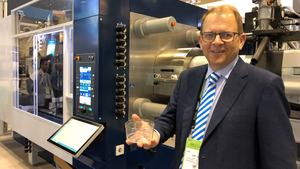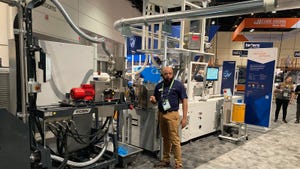Web-exclusive: The Materials Analyst, Part #90: The myth of overdrying—Part 2
October 1, 2007
|
It's more than semantics: Moisture removal is reversible, but improper moisture removal can cause polymer degradation-and that's not reversible.
In Part 1 of this topic we established that for many materials there is a relationship between moisture content and melt viscosity. Higher moisture contents result in lower melt viscosities and, as the moisture content declines, the melt viscosity increases. These viscosity increases are most easily documented at low shear rates and the relationship is nonlinear.
As the moisture content declines below a certain critical value, the increase in melt viscosity becomes more significant (see Figure 1). The effect that these viscosity increases have on the molded part depends a great deal on part geometry and the ability of the molding process to self-adjust for the viscosity change. Often, weak weldlines or other symptoms of underpacking produce a part with reduced strength and this property reduction is often attributed to what the industry has come to call overdrying.
However, there are other changes that can occur in a raw material as it is being dried that can be real contributors to a deterioration in part performance. Ideally, the drying process removes moisture from the raw material without producing any other changes in the polymer. However, extended drying times or elevated drying temperatures have the ability to remove other constituents from the material.
Plasticizers and other additives can be swept out of the resin by the drying process. Anyone who has ever found strange liquids or crystalline materials in their dryer filters can attest to this even if they did not know what they were witnessing at the time. Twenty-five years ago the instructions for drying some materials actually made provisions for the inclusion of a plasticizer trap placed in the return air line between the drying hopper and the desiccant beds. This prevented the fouling of the desiccant with a material that was a gas at the drying temperature but condensed to a liquid or even a solid once it cooled to room temperature.
If the plasticizers, stabilizers, and flow aids are removed by the drying process, the composition of the material has been changed. Plasticizers are used to reduce the hardness and stiffness of some materials. If this additive is removed, the material may become harder and more brittle. Stabilizers prevent deterioration due to oxidation. And if a flow enhancer is removed from the compound, the material will exhibit a higher viscosity. But this viscosity increase is not the same as the one caused by fluctuating moisture content. To understand the difference, it is important to distinguish between reversible and nonreversible processes.
Sometimes you can't go backwards
|
It is human nature to have a certain sense of what can and cannot happen in the real world. This is based on experience, but underlying that experience is a fundamental principle of physics known as the second law of thermodynamics. Simply put, this law states that, left to themselves, things proceed to a more random state. To increase order in a system requires some type of extraordinary intervention. Physicists use this principle in order to describe something they call the arrow of time.
A film of a glass falling off a table and breaking as it hits the floor looks normal because it fits our experience of what actually happens. If we saw small shards of glass flying upward from the floor and assembling themselves into an intact glass on the table, we would immediately conclude that the film was running backwards. In physics we recognize that this increase in order is not strictly impossible, but we know that the energy that would have to be put into the system to make it happen is too large to make the event even remotely likely. We consider the breaking of the glass to be, for all practical purposes, irreversible.
On the other hand, if we were to view film footage of a person walking across a room, we would have no way of determining whether that person was walking forward or if we were viewing a film running in reverse of a person walking across the room backward (unless there was a clock somewhere in view). We would deem both of these acts as possible because, aside from a lack of agility, there is nothing that makes the process of walking forward preferred over walking backward from the standpoint of energy expenditure. This is a reversible process.
Moisture removal and moisture gain in a polymer is a reversible process. Theoretically, it can occur an infinite number of times without altering the essential structure of the material. This is what enabled us in Part 1 of this topic to remove very dry nylon from a hopper and rehydrate it to make it process more easily. If, however, we had removed ingredients from the initial formulation during the drying process, this would be irreversible. If the removal of a processing aid resulted in a higher viscosity, that change would be permanent. Experiences with changes like this are what led our shift supervisor to believe that we had ruined the nylon and would have to throw it away.
Now consider the fact that we lump the two events of moisture removal and additive removal into the same category and use events attributable to additive removal to justify leaving moisture in the material because it supposedly improves properties. This is unfortunate because scientifically performed studies have shown that nylons, polyesters, and other condensation polymers actually exhibit better properties when more moisture is removed from the polymer.
Figure 2 shows the relationship between impact resistance and moisture content for two different grades of the same material as in Figure 1. The two grades differ in the molecular weight of the polymer used to formulate the compounds. But for both grades, notice what happens to the toughness of the product as the moisture content of the raw material used to produce the specimens goes down. Samples molded with material dried to 50 ppm (0.005%) are 20-35% more impact resistant than specimens molded with material dried to 200 ppm (0.02%).
Figure 3 shows the relationship between tensile strength of test specimens and the moisture content of the material used to mold those specimens. While the improvement is not as great as it is for impact performance (a little less than 10%), it is still measurable and unmistakable.
How much vs. how to
Is this new information? Actually, these results come from a broad study relating moisture content to properties for a number of materials. The study was published in 1986. Yet today, the industry continues to talk about overdrying without making any distinction between the reversible process of moisture gain and loss and the irreversible process of additive loss. Many processors firmly believe that they will make better parts if they just “leave a little moisture in the material†when in reality there is no such benefit.
What this comes down to is the difference between how much moisture is taken out and how it is taken out. The threat to composition is improper drying conditions-too hot for too long. While this may indeed remove a lot of moisture, it can also do irreparable damage to the material. It is this damage that causes brittle product, but moisture removal gets the blame. And removal of additives is actually not the greatest concern. Extended drying at elevated temperatures can reduce the average molecular weight of the polymer. This happens more often than processors realize and the material most often affected is nylon.
Manufacturers of nylon compounds typically recommend drying temperatures of 71-82°C (160-180°F), and with good reason. Most nylon materials are susceptible to a chemical process known as oxidation. All materials oxidize eventually under the right circumstances, but nylon does so readily at temperatures that can be achieved in resin drying equipment. Oxidation begins in nylons as a mild discoloration, but it can lead to an actual breakdown of the molecular weight of the polymer. This will cause the viscosity of the material to go down, but it is not a positive change. It is related to polymer degradation.
Figure 4 shows the results of a study that examined the effect of drying temperature on average molecular weight measured as melt flow rate (MFR). Note that at a drying temperature of 80°C (176°F), the material's MFR is stable even over an extended period of time. But when dried at 120°C (248°F) the MFR climbs quickly. The degradation is already at a critical point in less than 72 hours.
For those of you who think that this is something that never happens in the shop, consider: 1) dryers that are left on during weekend shutdowns to aid in quick Monday morning startups, 2) dryers that are left running when a job is set up but cannot be started right away due to lack of personnel, and 3) hoppers with an angle of repose that promotes funnel flow rather than plug flow of the material through the hopper. The last of these scenarios causes the material along the outer edge of the hopper to move very slowly as it feeds down to the bottom.
When parts were molded from the two materials in this study, the extended drying at 80°C did result in some reduction in impact strength compared with material that had been dried for a shorter period of time. But most of this impact was restored when the parts went through their natural process of hydration with moisture from the atmosphere. The material dried at 120°C produced parts that were extremely brittle regardless of their postmold conditioning. Conventional wisdom would teach that the reason for the difference in performance was overdrying. In reality, it was polymer degradation.
Remember, moisture gain and removal is like walking backwards; you can always reverse your field. The other things that happen during the drying process such as additive loss and polymer degradation are like breaking the glass.
You May Also Like






